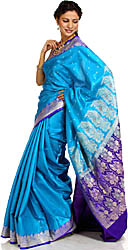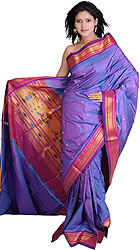Source(google.com.pk)
The etymology of the word sari or saree is from the Sanskrit word 'sati', which means strip of cloth. This evolved into the Prakrit 'sadi' and was later anglicised into sari (often spelled as saree).
Indian civilization has always placed a tremendous importance on unstitched fabrics like the sari and dhoti, which are given sacred overtones. The belief was that such a fabric was pure; perhaps because in the distant past needles of bone were used for stitching. Hence even to the present day, while attending pujas or other sacred ceremonies, the men dress up in dhotis while women wear the sari.
The Indian Sari, like so many other textiles, gives the lie to the hierarchical distinction made between fine arts and crafts. The approximate size of a sari is 47 by 216 inches. Although it is an untailored length of cloth, the fabric is highly structured and its design vocabulary very sophisticated. The main field of the sari is framed on three sides by a decorative frieze of flowering plants, figurative images, paisleys, or abstract symbols.
Two of the borders define the edges of the length of the sari and the third comprises the end piece, which is a more complex version of the other two borders. This end piece is the part of the sari that is draped over the shoulder and left to hang over the back or front, known popularly as the Pallu or Anchal.
The pallu usually elaborates the theme found in the two borders and the actual field of the sari, a sort of repetition and amplification in the manner of the Indian musical mode, the raga. This beautiful metaphor thus compares the two narrow borders to the introductory recital of the pure notes and the pallu to the song.
The design of the Indian Saree, whether woven, embroidered, painted or block-printed, needs to maintain the proportion and balance between the actual field of the sari, the borders and the pallu. The pattern creates its own rhythm.
Each sari in the modern era requires a matching set of blouse and underskirt for draping it. All saris in our collection come along with a matching blouse piece. You can also have the blouse and petticoat tailored to your custom measurements, at a nominal extra cost.
This world belongs to the woman as much as it belongs to the man. A woman is known for her modesty, patience, playfulness, forgiveness, and care. When a woman wears a saree, she looks like a fairy. Whether tall or short, slim or fat, a woman looks beautiful in a saree. The poem "Autobiography of an Indian Saree" portrays the features of an Indian saree.
The trend of wearing Sarees is not only common in India & Pakista; it is getting fame in the rest of the world because it offers a lot of fashion statements for stylish women. Women can wear Sarees on parties, weddings and other special occasions in their life.
Today we are going to share with you some of the best Sarees designs which include women party wear sarees, wedding wear sarees, formal and casual wear sarees for those women who wishes to look eye-catching and stylish in gatherings of special occasions.
Their fashion house IMBIAS is one of the biggest brands of Pakistan, known exclusively for impeccably created style-loaded wedding dresses. Their wedding collection includes Kurta for Mehndi, Sherwani for Barat, bridal lehngas and fancy party-wear for women. In addition to that, they also offer Khusa, Pagri with the bridal package.
Their wedding collections are grand amalgamations of timeless tradition and contemporary fashion. The other distinction of designers Imran and Rabia is their subtle ensembles.
Their fashion house IMBIAS is one of the biggest brands of Pakistan, known exclusively for impeccably created style-loaded wedding dresses. Their wedding collection includes Kurta for Mehndi, Sherwani for Barat, bridal lehngas and fancy party-wear for women. In addition to that, they also offer Khusa, Pagri with the bridal package
Esha deol wedding was an auspicious occasion. She was dressed to look best on her wedding day. Designers Neeta Lulla with her daughter Nishka Lulla was asked to make outfit for the bride and her family members for this grand occasion. Esha deol wedding was a mixture of South Indian and North Indian style. Esha deol wore a red and gold studded kanjeevaram sari which was brought from Chennai by Hema Malini to which designer Neeta Lulla made some appropriate changes. The younger sister Ahana Deol wore a silk sari and looked pretty as well. Hema Malini wore a kancheevaram sari which was redesigned by Neeta Lulla.
In South India and especially in Kerala, women from most communities wore only the sari and exposed the upper part of the body till the middle of the 20th century. Poetic references from works like Silappadikaram indicate that during the Sangam period in ancient Tamil Nadu, a single piece of clothing served as both lower garment and head covering, leaving the midriff completely uncovered.Similar styles of the sari are recorded paintings by Raja Ravi Varma in Kerala. By the mid 19th century, though, bare breasted styles of the sari faced social revaluation and led to the Upper cloth controversy in the princely state of Travancore (now part of the state of Kerala) and the styles declined rapidly within the next half a century.
In ancient India, although women wore saris that bared the midriff, the Dharmasastra writers stated that women should be dressed such that the navel would never become visible.By which for some time the navel exposure became a taboo and the navel was concealed.
Saree is well know type of dress in Indian and Pakistani culture. Female like to wear saree in parties, wedding and different ceremony. Saree dress is also popular in sri-lanka , Nepal and Bangladesh.A saree is a strip of un-stitched cloth, worn by females, ranging from four to nine yards in length that is draped over the body in various styles which is native to the Indian Subcontinent and blouse is used with saree. The sari is usually worn over a petticoat with a blouse known as a choli or ravika forming the upper garment.
Indian Sarees For Sale Indian Sarees 2014 Designs Online For Kids Images Design Patterns Online Shopping Wedding Blouse Designs

Indian Sarees For Sale Indian Sarees 2014 Designs Online For Kids Images Design Patterns Online Shopping Wedding Blouse Designs

Indian Sarees For Sale Indian Sarees 2014 Designs Online For Kids Images Design Patterns Online Shopping Wedding Blouse Designs

Indian Sarees For Sale Indian Sarees 2014 Designs Online For Kids Images Design Patterns Online Shopping Wedding Blouse Designs

Indian Sarees For Sale Indian Sarees 2014 Designs Online For Kids Images Design Patterns Online Shopping Wedding Blouse Designs

Indian Sarees For Sale Indian Sarees 2014 Designs Online For Kids Images Design Patterns Online Shopping Wedding Blouse Designs

Indian Sarees For Sale Indian Sarees 2014 Designs Online For Kids Images Design Patterns Online Shopping Wedding Blouse Designs
Indian Sarees For Sale Indian Sarees 2014 Designs Online For Kids Images Design Patterns Online Shopping Wedding Blouse Designs

Indian Sarees For Sale Indian Sarees 2014 Designs Online For Kids Images Design Patterns Online Shopping Wedding Blouse Designs

Indian Sarees For Sale Indian Sarees 2014 Designs Online For Kids Images Design Patterns Online Shopping Wedding Blouse Designs

Indian Sarees For Sale Indian Sarees 2014 Designs Online For Kids Images Design Patterns Online Shopping Wedding Blouse Designs
No comments:
Post a Comment